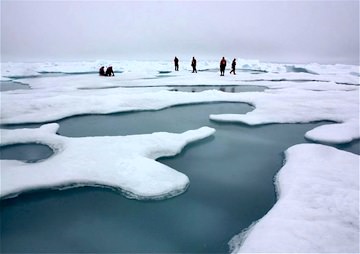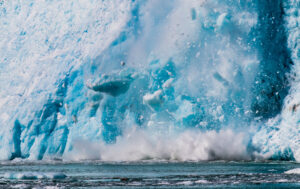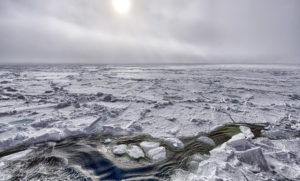Ice Loss Sends Alaskan Temperatures Soaring
Scientists analyzing more than three decades of weather data for the northern Alaska outpost of Barrow have linked an astonishing 7°C temperature rise to the decline in Arctic sea ice.
By Alex Kirby, Climate News Network

Melting point: researchers study Arctic sea ice and melt ponds on the Chuckchi Sea. Photo by NASA/Kathryn Hansen via Wikimedia Commons
This piece first appeared at Climate News Network.
LONDON — If you doubt that parts of the planet really are warming, talk to residents of Barrow, the Alaskan town that is the most northerly settlement in the US.
In the last 34 years, the average October temperature in Barrow has risen by more than 7°C — an increase that, on its own, makes a mockery of international efforts to prevent global temperatures from rising more than 2°C above their pre-industrial level.
A study by scientists at the University of Alaska Fairbanks analysed several decades of weather information. These show that temperature trends are closely linked to sea ice concentrations, which have been recorded since 1979, when accurate satellite measurements began.
The study, published in the Open Atmospheric Science Journal, traces what has happened to average annual and monthly temperatures in Barrow from 1979 to 2012.
Most striking
In that period, the average annual temperature rose by 2.7°C. But the November increase was far higher — more than six degrees. And October was the most striking of all, with the month’s average temperature 7.2°C higher in 2012 than in 1979.
Gerd Wendler, the lead author of the study and a professor emeritus at the university’s International Arctic Research Center, said he was “astonished”. He told the Alaska Dispatch News: “I think I have never, anywhere, seen such a large increase in temperature over such a short period.”
The study shows that October is the month when sea ice loss in the Beaufort and Chukchi Seas, which border northern Alaska, has been highest. The authors say these falling ice levels over the Arctic Ocean after the maximum annual melt are the reason for the temperature rise. “You cannot explain it by anything else,” Wendler said.
They have ruled out the effects of sunlight because, by October, the sun is low in the sky over Barrow and, by late November, does not appear above the horizon.
Instead, they say, the north wind picks up stored heat from water that is no longer ice-covered in late autumn and releases it into the atmosphere.
At first sight, the team’s findings are remarkable, as Barrow’s 7.2°C rise in 34 years compares with a global average temperature increase over the past century of up to about 0.8°C. But what’s happening may be a little more complex.
Warming faster
The fact that temperatures in and around Barrow are rising fast is no surprise, as the Arctic itself is known to be warming faster than most of the rest of the world.
The Intergovernmental Panel on Climate Change says observed warming in parts of northern Alaska was up to 3°C from the early 1980s to the mid-2000s. It also concludes that about two-thirds of the last century’s global temperature increase has occurred since 1980.
But Barrow’s long-term temperature rise has not been uniform, the Fairbanks study says. Its analysis of weather records between 1921 and 2012 shows a much more modest average annual rise, of 1.51°C. In 2014, the city experienced the coolest summer day recorded — 14.5°C.
So one conclusion is to remember just how complex a system the climate is — and how even 34 years may be too short a time to allow for any certainty.
Your support is crucial...As we navigate an uncertain 2025, with a new administration questioning press freedoms, the risks are clear: our ability to report freely is under threat.
Your tax-deductible donation enables us to dig deeper, delivering fearless investigative reporting and analysis that exposes the reality beneath the headlines — without compromise.
Now is the time to take action. Stand with our courageous journalists. Donate today to protect a free press, uphold democracy and uncover the stories that need to be told.






You need to be a supporter to comment.
There are currently no responses to this article.
Be the first to respond.